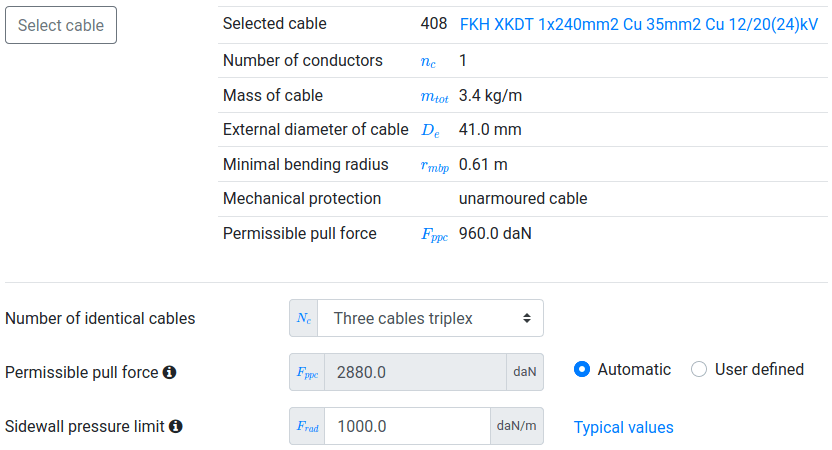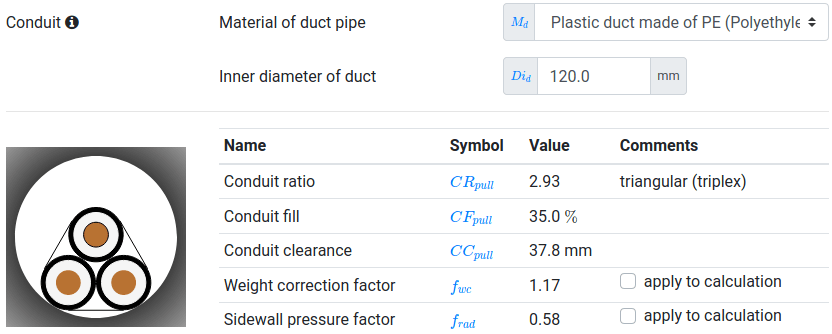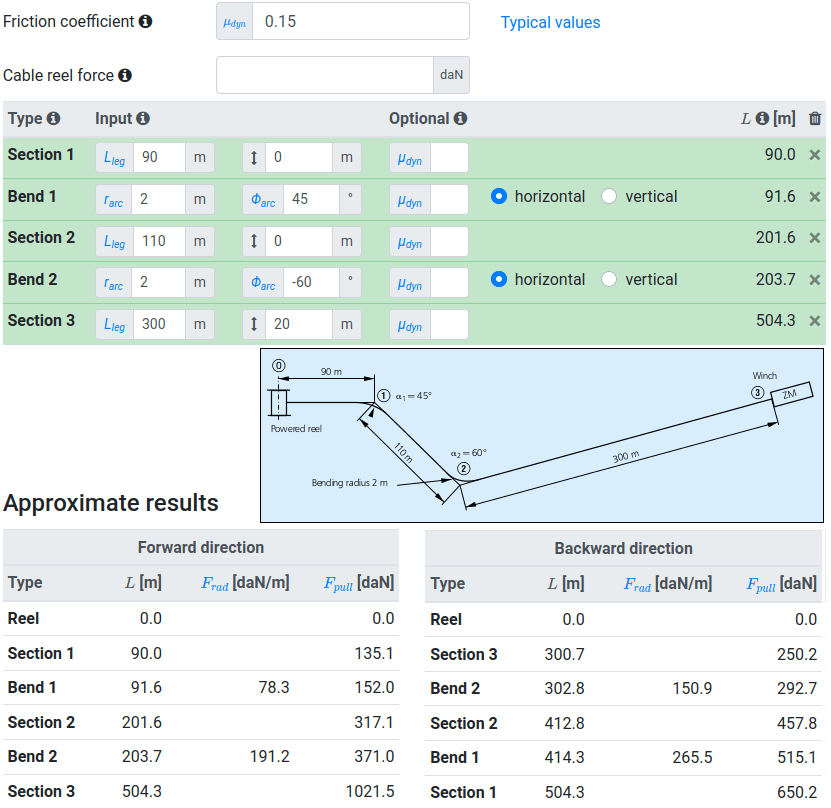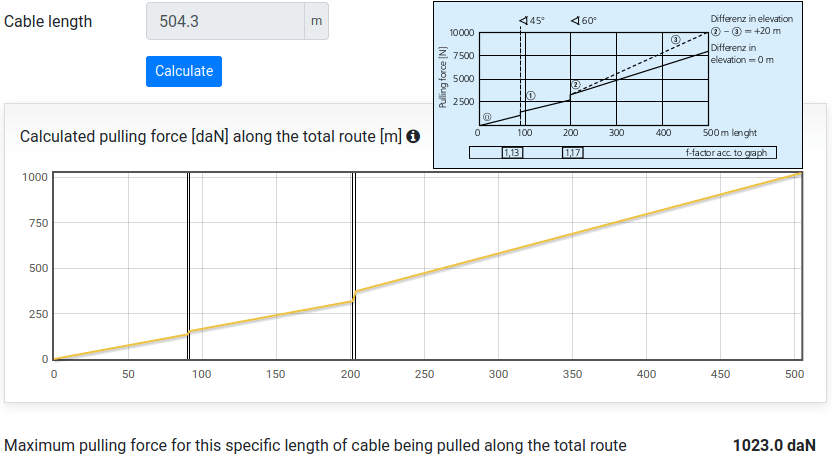On an example from Brugg Cables, it is shown how to set up your cable pulling project in Cableizer. This example validates our cable pulling module and has been added to our test cases, ensuring that cable pulling calculations won't unexpectedly and unnoticeably change.
Posted 2021-05-24
Categories: User guides, Validation
The following calculation example from Brugg Cables is an extract from their cable catalogue titled Manual for Transportation and Cable Laying Maintenance from 2016. The calculation example is found on pages 12ff. The cut-outs with light blue background in the following images are copied from this manual for illustrative purposes.
In the Cable tab of the cable pulling module the cable is selected, which in the example is of type XKDT 1x240/35 mm² , 20/12 kV. Cableizer does display all relevant cable properties, which closely correspond to the values in the Brugg Cables manual (Cable weight $m_{tot}$ per m of 3.36 kg, cable diameter $D_e$ of 41 mm, minimum bending radius $r_{mbp}$ of 615 mm, permissible pull force $F_{ppc}$ of 9600 N). Please be aware that Cableizer outputs all forces in [daN] (10 N = 1 daN). In addition it is shown if the cable is a single-core or a multi-core cable, and whether or not it is armoured (for armoured cables, it is possible to select pull on the armour in the cable editor as an alternative to pull on the conductor).
Once the cable has been selected, it is time to select the number of cables that are pulled in together, which in this case is 3. Brugg Cables does not mention whether or not the cables are bound together (triplex), but from their admissible pull force which is 28800 N and thus thrice the permissible pull force of a single cable, it is concluded that the cables are assumed to be bound together. For three unbound cables the total permissible pull force is normally assumed to be only twice the permissible pull force of a single cable, as the two cables on the bottom will take all the force (the cable laying on top is not exposed to any friction). If the automatically calculated limit is not suitable, it can be manually entered (e.g. if the pull is made with woven mesh pulling grips). The admissible sidewall pressure has been selected as 10000 N/m in accordance with the Brugg Cables manual.
Both the permissible pull force and sidewall pressure limit values are optional. However, they should not be omitted as the program will clearly indicate if those limits are exceeded along your cable route.

In the Conduit tab of the cable pulling module a PE conduit with an inner diameter of 120 mm is selected in accordance with the Brugg Cables manual.
The conduit ratio $CR_{pull}$, the conduit fill $CF_{pull}$, and the conduit clearance $CC_{pull}$ all show that the conduit dimensions are suitable for the intended cable pull. The conduit jamming ratio $CJ_{pull}$ is not displayed since the three cables are bound together (triplex) and there is no risk for jamming. Please notice that the conduit preview is up to scale and helps to avoid possible input errors.
Brugg Cables calculates without weight correction factor $f_{wc}$ and sidewall pressure factor $f_{rad}$, and so they have not been applied to our calculation. Please consult with your supplier whether or not to apply these factors to your calculations.

In the Routing tab of the cable pulling module the example route (cut-out with light blue background below) is composed of sections and bends. Please notice that the length of the cable route is slightly different between Cableizer and the Brugg Cables example due to the way the bends are handled. We have also focused on the alternative with an elevation of 20 m within the last section.
The friction coefficient $\mu_{dyn}$ is 0.15 all along the route (Cableizer does allow optional individual inputs for every section or bend). And since the reel is powered, there is no cable reel force.
The approximate results show a good agreement with the Brugg Cables manual, which states a maximum pulling force $F_{pull}$ of 10215 N and a maximum sidewall pressure $F_{rad}$ of 1858 N/m. The difference in the sidewall bearing pressure is due to the fact that Cableizer is calculating with the inside bending radius of the conduit, while Brugg Cables is considering the radius of the centerline of the bend $r_{arc}$ (which is also used as input in Cableizer).
The results also show that it is beneficial to opt for a pull in the forward direction if the sidewall bearing pressure is the limiting factor (bends are at the start of the route), or in the backward direction if the pulling force is the limiting factor (downward slope in section 3 instead of upward slope).

In the Forward direction and Backward direction tabs of the cable pulling module, the pull force curves and radial force curves can be calculate and displayed. As shown below, the forward pull force curve does correspond to the curve from the Brugg Cables manual (with light blue background).

If the cable that is pulled in is delivered in multiple sections, it is now possible to set a cable length that is shorter than the cable route and get corresponding pull force and sidewall bearing pressure curves. This feature has been added on customer request. Please let us know if you have any proposals for improvements or clarifications.